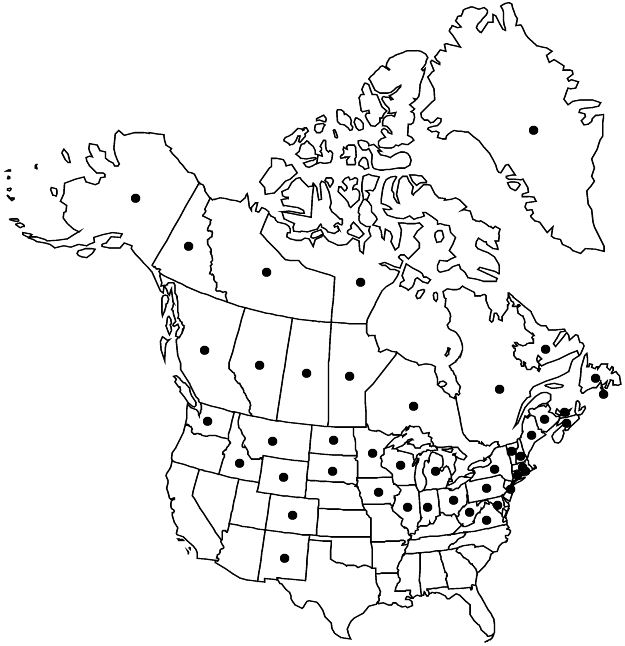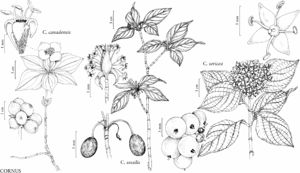Cornus canadensis
Sp. Pl. 1: 118. 1753.
Stems erect, green, 5–25 cm, appressed-hairy; nodes 4–6, internodes progressively longer distally; branches only at distalmost node, much shorter than distal internodes so stems appear unbranched. Leaves at all but distalmost node nonchlorophyllous, opposite, scalelike, caducous, at distalmost node chlorophyllous, appearing to in whorl of 6 (sometimes 4 on sterile stems), well developed, persistent; distalmost leaves: petiole 0.5–2.8 mm; blade obovate, ovate, elliptic, or rhombic, 2–7 × 1–4.5 cm, apex acute or short acuminate, abaxial surface pale green, sparsely appressed-hairy to glabrate, adaxial surface green, appressed-hairy; secondary-veins 2–3 per side, all arising from proximal 1/2. Inflorescences 12–40-flowered; peduncle 10–30 mm; primary branches 0.5–2.5 mm; bracts greenish white to white, occasionally red-tipped or red-tinged, ± equal, ovate, 5–15 × 5–15 mm, apex acute to acuminate. Pedicels 0.5–3 mm, sparsely appressed-hairy. Flowers: hypanthium cream, 1–2 mm, densely appressed-hairy; sepals cream, turning purple as fruit matures, 0.1–0.3 mm, apex rounded, membranous, glabrous, eglandular; petals cream, 1–2 mm, apical awn 0.3–1.2 mm; nectary cream or purplish black. Drupes 5–15 per infructescences, red, globose, 6–9 mm; stone ovoid, 2.3–3.3 × 1.7–2.3 mm, smooth, apex rounded. 2n = 22, 44.
Phenology: Flowering May–Jul; fruiting Aug–Oct.
Habitat: Dry to moist broadleaf or coniferous forests, roadbanks, marshes, bogs.
Elevation: 0–3400 m.
Distribution

Greenland, St. Pierre and Miquelon, Alta., B.C., Man., N.B., Nfld. and Labr., N.W.T., N.S., Nunavut, Ont., P.E.I., Que., Sask., Yukon, Alaska, Colo., Conn., Idaho, Ill., Ind., Iowa, Maine, Md., Mass., Mich., Minn., Mont., N.H., N.J., N.Mex., N.Y., N.Dak., Ohio, Pa., R.I., S.Dak., Vt., Va., Wash., W.Va., Wis., Wyo., Asia
Discussion
C. Gervais and M. Blondeau (2003) showed that Cornus canadensis includes both diploid and tetraploid populations, which can be distinguished solely by pollen size and chromosome number. The diploids, which they called subsp. pristina, are found in Alaska and western and northern Canada (including the northern parts of Labrador and Quebec), and the tetraploids, which they called subsp. canadensis, are found in eastern Canada and the northeastern United States. Unfortunately, Gervais and Blondeau did not sample populations from most of the species’ distribution in the United States.
Reports of Cornus canadensis from California and Oregon (for example, C. L. Hitchcock A. Cronquist 1973; J. R. Shevock 2012) represent C. unalaschkensis.
Selected References
None.
